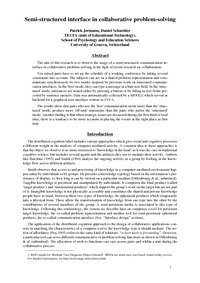Semi-structured interface in collaborative problem-solvingErstpublikation in: first swiss workshop on distributed and parallel systems
Publikationsdatum:
|
 |
 Diese Seite wurde seit 19 Jahren inhaltlich nicht mehr aktualisiert.
Unter Umständen ist sie nicht mehr aktuell.
Diese Seite wurde seit 19 Jahren inhaltlich nicht mehr aktualisiert.
Unter Umständen ist sie nicht mehr aktuell.
 Zusammenfassungen
Zusammenfassungen

 The aim of this research is to observe the usage of a semi-structured communication interface in collaborative problem-solving in the light of recent research on collaboration.
Ten mixed pairs have to set up the schedule of a working conference by taking several constraints into account. The subjects can act on a shared problem representation and communicate synchronously by two modes inspired by previous work on structured communication interfaces. In the 'free' mode, they can type a message in a bare text field. In the 'structured' mode, utterances are issued either by pressing a button or by filling in text fields preceded by sentence openers. Data was automatically collected by a MOO[1] which served as backend for a graphical user interface written in JAVA.
The results show that pairs who use the 'free' communication mode more than the 'structured' mode, produce more 'off-task' statements than the pairs who prefer the 'structured' mode. Another finding is that when strategic issues are discussed during the first third of total time, there is a tendency to be more accurate in placing the events at the right place at first trial.
The aim of this research is to observe the usage of a semi-structured communication interface in collaborative problem-solving in the light of recent research on collaboration.
Ten mixed pairs have to set up the schedule of a working conference by taking several constraints into account. The subjects can act on a shared problem representation and communicate synchronously by two modes inspired by previous work on structured communication interfaces. In the 'free' mode, they can type a message in a bare text field. In the 'structured' mode, utterances are issued either by pressing a button or by filling in text fields preceded by sentence openers. Data was automatically collected by a MOO[1] which served as backend for a graphical user interface written in JAVA.
The results show that pairs who use the 'free' communication mode more than the 'structured' mode, produce more 'off-task' statements than the pairs who prefer the 'structured' mode. Another finding is that when strategic issues are discussed during the first third of total time, there is a tendency to be more accurate in placing the events at the right place at first trial. im Text Semi-structured interface in collaborative problem-solving (1997)
im Text Semi-structured interface in collaborative problem-solving (1997)  Dieser Text erwähnt ...
Dieser Text erwähnt ...
 Zitationsgraph
Zitationsgraph
 Zitationsgraph (Beta-Test mit vis.js)
Zitationsgraph (Beta-Test mit vis.js)
 2 Erwähnungen
2 Erwähnungen 
- Collaborative Learning - Cognitive and Computational Approaches (Pierre Dillenbourg) (1999)
- Three worlds of CSCL - Can we support CSCL (Paul A. Kirschner) (2002)
- Over-scripting CSCL - The risks of blending collaborative learning with instructional design (Pierre Dillenbourg)


- Over-scripting CSCL - The risks of blending collaborative learning with instructional design (Pierre Dillenbourg)
 Volltext dieses Dokuments
Volltext dieses Dokuments
 |  Semi-structured interface in collaborative problem-solving: Artikel als Volltext ( Semi-structured interface in collaborative problem-solving: Artikel als Volltext ( : :  , 51 kByte; , 51 kByte;  : :  2021-03-21) 2021-03-21) |
 Anderswo suchen
Anderswo suchen 
 Beat und dieser Text
Beat und dieser Text
Beat war Co-Leiter des ICT-Kompetenzzentrums TOP während er Dieser Text ins Biblionetz aufgenommen hat. Zum letzten Mal hat er Dieser Text bearbeitet während seiner Zeit am ICT-Kompetenzzentrum TOP. Beat besitzt kein physisches, aber ein digitales Exemplar. Eine digitale Version ist auf dem Internet verfügbar (s.o.). Aufgrund der wenigen Einträge im Biblionetz scheint er es nicht wirklich gelesen zu haben. Es gibt bisher auch nur wenige Objekte im Biblionetz, die dieses Werk zitieren.










 Biblionetz-History
Biblionetz-History